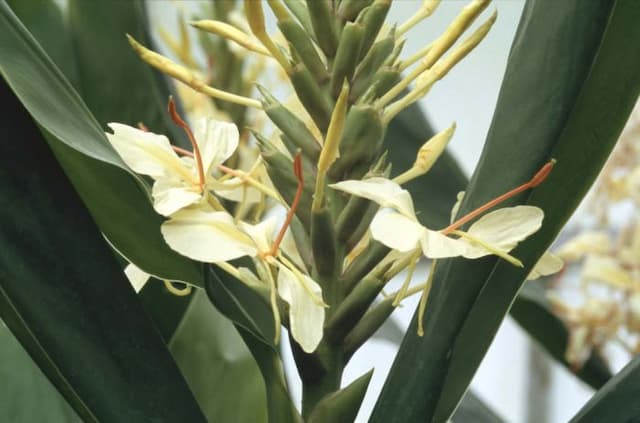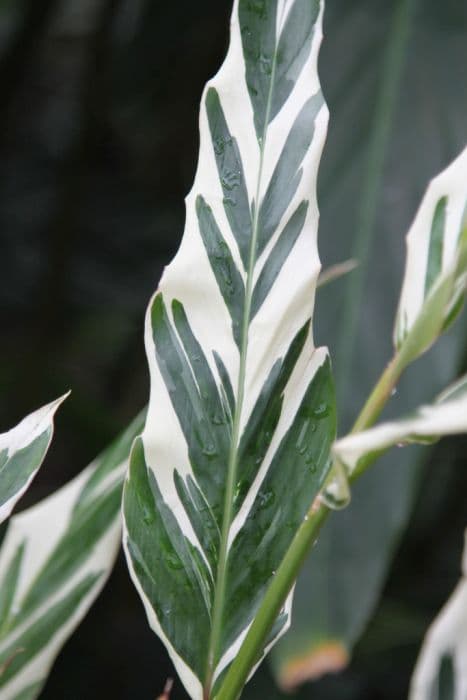Ginger Zingiber officinale

ABOUT
Zingiber officinale, commonly known as ginger, is a flowering plant with a distinct appearance that is widely recognized for its culinary and medicinal uses. The plant showcases thick, fibrous roots that are pale yellow on the inside and a brownish skin on the outside. These roots, or rhizomes, grow horizontally beneath the soil and are the main part used in cooking and for health benefits. Above the ground, ginger plants have elongated, green leaves that can be quite lush. The leaves grow from the stem in alternate pairs, each leaf being long and narrow with a pronounced midrib. When ginger blooms, which may not occur in all growing conditions, the plant produces small, cone-shaped, greenish-yellow flowers. These flowers may have faint purple streaks and are often arranged in spikes. The blossoms appear on separate shoots directly from the rhizome and have an exotic look, although they are not as commonly seen as the roots of the plant. The appearance of the ginger plant, with its vibrant green leaves and intricate flowers when in bloom, combined with the distinctive characteristics of its highly valued rhizomes, makes it both an attractive and useful plant in various settings. Its roots, when mature, are often harvested and used in various forms such as fresh, dried, powdered, or as an oil or juice.
About this plant
 Names
NamesFamily
Zingiberaceae.
Synonyms
Ginger, Common Ginger, Culinary Ginger, Garden Ginger, Jamaican Ginger, True Ginger.
Common names
Amomum zingiber L., Zingiber blancoi Hassk., Zingiber majus Rumph.
 Toxicity
ToxicityTo humans
Ginger, which is the most common name for Zingiber officinale, is not toxic to humans when consumed in typical food amounts. It is commonly used as a spice and has a long history of use in cooking and traditional medicine. However, consuming ginger in very large quantities could potentially lead to gastrointestinal irritation, heartburn, diarrhea, and mouth irritation. Ginger may also interact with certain medications, so individuals should consult with a healthcare provider if they are on anticoagulants or other medications. Nevertheless, ginger is generally safe when used as a culinary spice or consumed in moderation as a dietary supplement.
To pets
Ginger is known to be non-toxic to pets in small doses. While it is commonly used by humans as a spice, pets, including dogs and cats, can consume ginger in small amounts without significant risk of poisoning. However, large quantities might cause mild stomach upset. As with any food item not typically present in a pet's diet, it is best to consult with a veterinarian before offering ginger to ensure it is appropriate for that specific pet and to avoid any potential interactions with medications or health conditions. Generally, moderate amounts of ginger can be safely offered to pets.
 Characteristics
CharacteristicsLife cycle
Perennials
Foliage type
Evergreen
Color of leaves
Green
Flower color
Yellow
Height
2-3 feet (0.61-0.91 meters)
Spread
2-3 feet (0.61-0.91 meters)
Plant type
Herb
Hardiness zones
9-12
Native area
Asia
Benefits
 General Benefits
General Benefits- Culinary Use: Zingiber officinale, commonly known as ginger, is widely used as a spice and flavoring agent in various cuisines.
- Aromatic: Ginger has a distinctive, pungent aroma that adds a warm fragrance to dishes and products like teas and baked goods.
- Digestive Aid: Ginger can help aid digestion by stimulating saliva, bile, and gastric enzymes.
- Nausea Relief: Chewing on ginger or drinking ginger tea can help alleviate symptoms of nausea and motion sickness.
- Anti-inflammatory Effects: The gingerol compounds in ginger may help reduce inflammation, thereby providing comfort in conditions that cause inflammation-based pain.
- Antioxidants: Ginger contains multiple antioxidant compounds, which help protect the body from oxidative stress and support overall health.
 Medical Properties
Medical Properties- Anti-inflammatory: Zingiber officinale, commonly known as ginger, contains gingerol, which has anti-inflammatory properties.
- Antiemetic: It is often used to help alleviate nausea and vomiting, particularly in cases of motion sickness, chemotherapy-induced nausea, and pregnancy-related morning sickness.
- Antioxidant: Ginger has antioxidant effects, potentially protecting cells from oxidative stress.
- Digestive Aid: It can aid in digestive health by stimulating saliva, bile, and gastric enzymes, which can help improve digestion and reduce bloating and gas.
- Analgesic: Ginger may reduce pain levels, commonly used for menstrual pain and muscle soreness.
- Antimicrobial: It has demonstrated antimicrobial activity against a variety of pathogens, including bacteria and fungi.
- Anti-diabetic: Some studies suggest ginger can aid in the management of blood sugar levels, though more research is needed to confirm this effect.
- Cholesterol-lowering: There is evidence that ginger can help reduce high cholesterol levels, a risk factor for heart disease.
- Anticancer Potential: Compounds found in ginger have been studied for their potential to prevent or slow the growth of cancer cells.
 Air-purifying Qualities
Air-purifying QualitiesThis plant is not specifically known for air purifying qualities.
 Other Uses
Other Uses- Culinary Spice: Ginger, the spice made from Zingiber officinale, is widely used for flavoring in cooking and baking, particularly in gingerbread, cookies, cakes, and savory dishes.
- Motion Sickness Remedy: Ginger can be used to alleviate symptoms of motion sickness including dizziness, nausea, and cold sweating.
- Perfumery: Ginger oil, extracted from the rhizomes of the plant, is occasionally used in perfumery for its oriental and fresh notes.
- Molasses Substitute: Ginger juice can be reduced down to a syrup and used as a molasses substitute in culinary recipes for a different flavor profile.
- Natural Fertilizer: Composted Zingiber officinale waste, such as the skin and pulp remaining after juice extraction, can be turned into fertilizer for gardens.
- Textile Dye: Extracts from Ginger can be used to dye textiles, yielding a range of tones from soft yellows to warm oranges depending on mordanting process.
- Craft Material: Dried ginger root can be used to make decorative items and craft projects due to its interesting texture and shape.
- Insect Repellant: Ginger oil has properties that can repel certain insects, making it a natural option to use in homemade insect repellent sprays.
- Meat Tenderizer: Due to certain enzymes present in ginger, it can be used as a natural meat tenderizer, breaking down the proteins in meat and making it more tender.
- Vegetable Paper: Thin slices of zingiber officinale can be dried and pressed to create a type of edible paper used as a unique wrapping for candies, or as a decorative edible garnish.
Interesting Facts
 Feng Shui
Feng ShuiZingiber officinale, commonly known as ginger, is not typically used in Feng Shui practice.
 Zodiac Sign Compitability
Zodiac Sign CompitabilityGinger is not used in astrology practice.
 Plant Symbolism
Plant Symbolism- Healing: Zingiber officinale, commonly known as ginger, is renowned for its medicinal properties, symbolizing healing and health due to its extensive use in traditional and modern medicine to treat various ailments.
- Protection: Ginger is believed to possess protective qualities. It symbolizes safeguarding one's health and well-being, often used in rituals and practices intended to ward off negativity and promote positive energy.
- Vitality: With its pungent and invigorating flavor, ginger stands for vitality and energy. It encapsulates the idea of spicing up one's life, bringing zest and enthusiasm.
- Prosperity: In some cultures, ginger is associated with wealth and abundance, symbolizing prosperity and success, possibly because of its once-high value in trade and commerce.
- Strength: The strong and spicy taste of ginger reflects the idea of inner strength and resilience, representing the capability to face challenges and adversity.
 Water
WaterThe Ginger plant requires consistent moisture, so it should be watered thoroughly when the top inch of soil feels dry. Typically, this means watering once a week, but this frequency may increase during hot, dry periods or if the plant is in a particularly sunny spot. It's best to provide approximately 1 gallon of water per plant each time you water, ensuring you soak the soil completely without leaving the plant in standing water. Adjust the amount of water depending on the size of the pot and the rate of growth, with larger, more mature plants potentially requiring more water.
 Light
LightGinger prefers bright, indirect sunlight and should be positioned in a spot that receives partial shade to prevent scorching of its leaves. A location with filtered sunlight, like under a canopy of trees or behind a sheer curtain near a sunny window, is ideal. Direct afternoon sun can be too intense and can harm the plant, so ensure that the lighting is consistently gentle throughout the day.
 Temperature
TemperatureGinger thrives in warm conditions and the ideal temperature range for this plant is between 75°F to 85°F. Ginger needs to be protected from cold drafts and temperatures below 50°F, as cold can severely damage the plant. It will not survive freezing temperatures, so if grown outdoors, the Ginger plant should be brought inside or provided with protection when temperatures start dropping below this threshold.
 Pruning
PruningPruning Ginger is mainly done to remove any dead or yellowing leaves and to maintain plant health, rather than to encourage shaping. The best time to prune is in the late summer or early fall, after the plant has finished flowering and the leaves begin to die back naturally. Pruning should be performed sparingly, as Ginger does not typically require heavy cutting back, so only remove parts of the plant that are dead or damaged.
 Cleaning
CleaningAs needed
 Soil
SoilGinger prefers a rich, loamy soil that provides good drainage. A mix containing equal parts garden soil, compost, and perlite or sand is ideal. The soil pH should be slightly acidic to neutral, ranging from 6.0 to 7.0.
 Repotting
RepottingGinger, commonly known as Ginger, should be repotted every one to two years. Repotting is best done during the late winter or early spring before the growing season begins.
 Humidity & Misting
Humidity & MistingGinger thrives in high humidity conditions, ideally between 60% to 80% relative humidity. Regular misting can help maintain these humidity levels if needed.
 Suitable locations
Suitable locationsIndoor
Keep Ginger in warm, indirect light, and maintain high humidity.
Outdoor
Plant Ginger in partial shade, moist, well-draining soil.
Hardiness zone
9-12 USDA
 Life cycle
Life cycleThe common name for Zingiber officinale is ginger. The life cycle begins with seed rhizome planting in moist, fertile soil, often after a period of dormancy. Germination ensues, leading to the emergence of a shoot and the first leaves within a week or two, depending on conditions. The plant goes through a vegetative stage where it forms pseudostems formed by leaf bases and continues to grow until it reaches maturity, which can take up to 8-10 months. Once mature, ginger plants produce small, yellowish-green flowers and may develop seed capsules, although reproduction typically occurs vegetatively through rhizome segments. After flowering, the plant enters a period of senescence, the aerial parts die back, and the rhizomes can be harvested, with some left in the ground to begin the next life cycle.
 Propogation
PropogationPropogation time
Late Winter to Early Spring
Propogation: The most popular method of propagating ginger, the common name for Zingiber officinale, is through the division of rhizomes. This is typically done in late winter or early spring before the growth season begins. A healthy, mature ginger rhizome is chosen and divided into pieces, making sure each section has at least one eye, similar to a potato eye, from which new shoots can grow. These rhizome pieces are then planted about 1 inch deep (2.54 cm) and spaced approximately 8 inches apart (20.32 cm) in rich, well-draining soil. The soil is kept consistently moist, and with the right warmth and humidity, the pieces will sprout and eventually grow into individual ginger plants.









